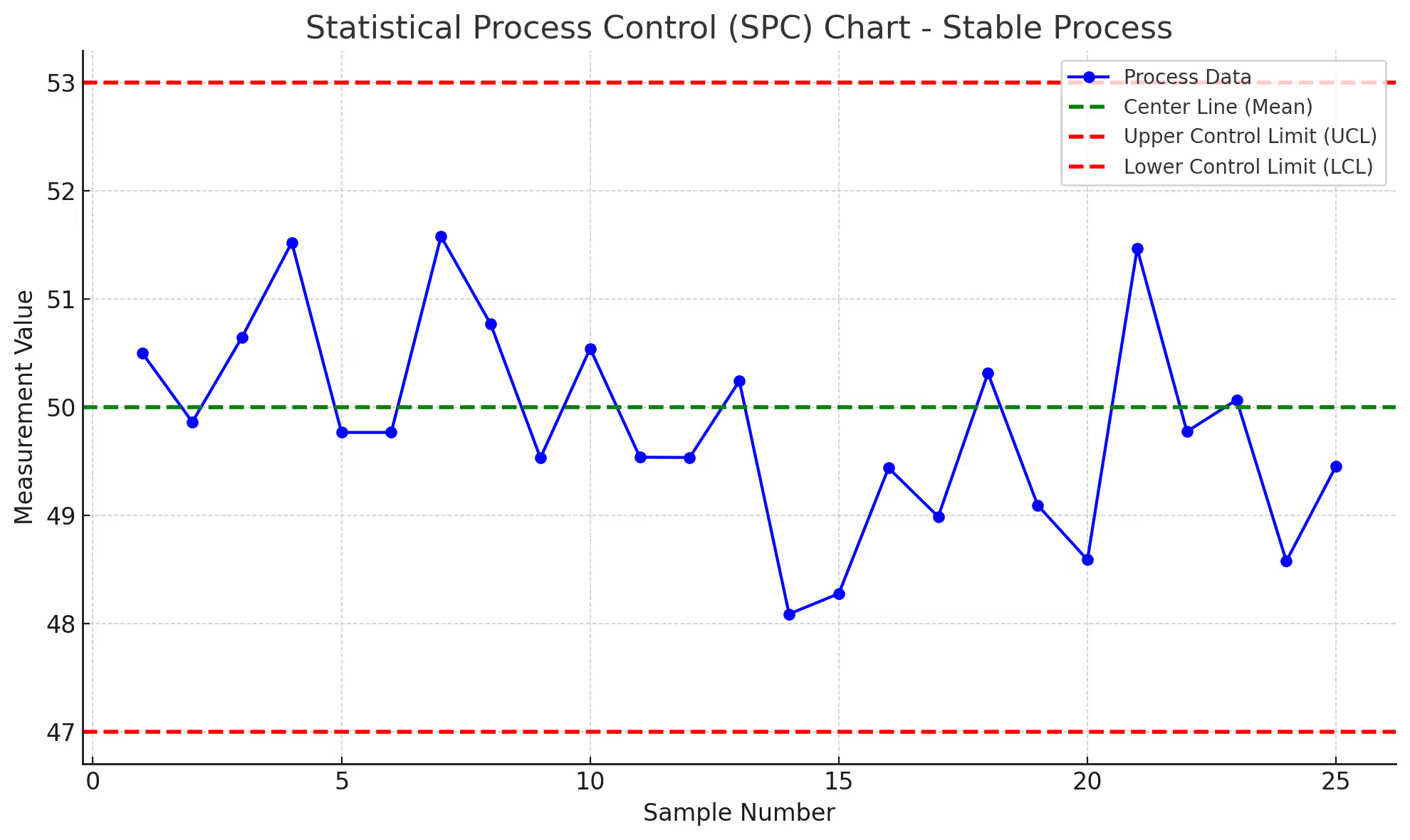🎯 Quick Answer
What: Lean Six Sigma combines waste elimination (Lean) with variation reduction (Six Sigma) to improve processes through data-driven methods.
Why It Matters: Organizations implementing Lean Six Sigma properly see 20-40% improvement in efficiency, quality, and customer satisfaction.
How to Apply: Follow the DMAIC methodology (Define, Measure, Analyze, Improve, Control) with trained Green Belts and Black Belts leading projects.
Expected Results: Most organizations achieve 3-5x ROI within 18 months, with semiconductor manufacturers seeing yield improvements of 15-30%, hospitals reducing readmissions by 20-40%, and oil & gas operations cutting safety incidents by 50-70%.
The Conference Room Disconnect
Picture this scene.
A boardroom filled with executives reviewing quarterly results. Revenue missed by 12%. Customer complaints up 23%. Production delays costing $2 million weekly.
The quality director presents a solution: implement Lean Six Sigma. Heads nod. Consultants are hired. Training begins.
Eighteen months later?
That same boardroom reviews new results. The improvements? Marginal at best.
The consultants blame "resistance to change." The employees blame "another management fad." The executives? They move on to the next solution.
Now Picture Something Different
A semiconductor fab in Asia where yield jumped from 67% to 94% using the same Lean Six Sigma tools.
A regional hospital system that reduced patient readmissions by 22%.
An oil platform that eliminated fatal incidents after five years of near-misses.
Same methodology. Vastly different results.
The difference? Understanding what Lean Six Sigma actually is versus what the textbooks say it should be.
Beyond the Textbook Definition
Lean Six Sigma represents the marriage of two powerful methodologies:
Lean focuses on eliminating waste and improving flow
Six Sigma targets variation reduction through statistical methods
Together, they promise operational excellence.
The textbooks make it sound straightforward:
Define the problem
Measure current performance
Analyze root causes
Improve the process
Control the gains
Simple, right?
The Field Reality
Here's what 35+ years across 21 countries reveals:
Lean Six Sigma succeeds brilliantly when understood correctly.
It fails spectacularly when treated as just another toolkit.
The methodology itself isn't wrong. The implementation approach usually is.
After seeing process improvements worth $4.4 billion across semiconductor manufacturing, healthcare systems, and oil & gas operations, clear patterns emerge.
💡 Three Critical Truths the Textbooks Rarely Mention:
Lean Six Sigma is a language, not just a methodology
The tools are universal but the application must be local
Certification creates capability but culture determines success
The Language of Process Excellence
Consider how a Master Black Belt views a hospital emergency department.
Where others see chaos, pattern recognition reveals predictable flow variations:
The Monday morning surge
The Friday night trauma spike
The discharge bottleneck at shift change
These aren't random events. They're statistical patterns waiting for analysis.
Same Lens, Different Industry
Apply this lens to a semiconductor factory:
Yield variations by shift
Equipment degradation curves
Human factors in cleanroom protocol violations
A major oil company's offshore platform shows similar patterns:
Safety incident timing
Maintenance delays
Production variations
The Vocabulary That Changes Everything
Lean Six Sigma provides precise vocabulary for these patterns:
Common Cause Variation vs Special Cause Variation
Not academic jargon
Diagnostic tools that save millions
Separates systemic issues from one-off events
DMAIC
Not just an acronym
A disciplined thinking process
Prevents jumping to solutions before understanding problems
Value Stream Mapping
Not just a flowchart
Reveals where value gets created and destroyed
Works in patient care, chip production, or oil extraction
📊 Key Insight: This language transcends industries. A control chart works identically in a hospital lab and a manufacturing plant. The data differs. The principles don't.
The Universal Tools, Local Application Paradox
Statistical Process Control (SPC) originated in manufacturing.
Yet some of the most impressive SPC implementations now exist in healthcare.
Real Example: Hospital Transformation
A multi-hospital system reduced surgical infections by 73% using control charts originally designed for factory production lines.
The tools transferred perfectly.
The implementation required complete reimagination.
Same Tool, Different Scale
Consider how SPC adapts across industries:
| Industry | SPC Monitors | Scale | Impact |
|---|---|---|---|
| Semiconductor | Particle counts | Parts per billion | Yield improvement |
| Healthcare | Infection rates | Per 1,000 patient days | Lives saved |
| Oil & Gas | Safety incidents | Per million work hours | Injuries prevented |
Same tool. Different scale. Different metrics. Identical mathematical principles.
The Critical Mistake
Organizations copy implementations rather than adapting principles.
❌ Wrong: Using a semiconductor fab's Six Sigma approach verbatim in a hospital
✅ Right: Applying the underlying pattern recognition while reinventing the implementation
Value Stream Mapping Across Industries
See how the same tool transforms for different contexts:
Manufacturing: Tracks physical products through production steps
Healthcare: Follows patients through care processes
Oil & Gas: Traces crude oil from extraction to refining
Each map looks different. The waste identification principles remain constant.
The Eight Wastes: Universal DOWNTIME Patterns
The Eight Wastes of Lean manifest differently but follow patterns across industries:
1. Defects ❌
Definition: Work that contains errors or lacks something necessary, requiring rework or scrapping.
Healthcare: Medical errors requiring intervention or readmission
Manufacturing: Product defects needing repair or replacement
Oil & Gas: Equipment failures causing unplanned shutdowns
Universal Pattern: Failure costs multiplying downstream
2. Overproduction 📈
Definition: Producing more, earlier, or faster than required by the next process or customer.
Healthcare: Unnecessary procedures or excessive testing
Manufacturing: Making more than demand requires
Oil & Gas: Processing beyond specification requirements
Universal Pattern: Creating upstream waste and hiding problems
3. Waiting ⏱️
Definition: Idle time when resources are not being used productively.
Healthcare: Patients waiting for test results or bed assignments
Manufacturing: Production lines waiting for parts or approvals
Oil & Gas: Crews waiting for permits or equipment availability
Universal Pattern: Idle time destroying efficiency
4. Non-Utilized Talent 🧠
Definition: Underutilizing people's skills, creativity, and knowledge.
Healthcare: Nurses doing administrative tasks instead of patient care
Manufacturing: Operators not consulted on process improvements
Oil & Gas: Field expertise ignored in engineering decisions
Universal Pattern: Lost innovation and engagement opportunities
5. Transportation 🚛
Definition: Unnecessary movement of products, materials, or information.
Healthcare: Moving patients unnecessarily between units
Manufacturing: Moving materials inefficiently across plants
Oil & Gas: Shuttling crews between platforms unnecessarily
Universal Pattern: Movement that adds no value
6. Inventory 📦
Definition: Excess products, materials, or information waiting to be processed.
Healthcare: Excess medical supplies taking space and expiring
Manufacturing: Raw materials sitting idle in warehouses
Oil & Gas: Spare parts inventory exceeding critical needs
Universal Pattern: Resources tied up unproductively
7. Motion 🚶
Definition: Unnecessary movement of people that doesn't add value.
Healthcare: Nurses walking miles per shift finding supplies
Manufacturing: Operators reaching repeatedly for tools
Oil & Gas: Technicians climbing platforms for routine checks
Universal Pattern: Wasted human energy and safety risks
8. Extra-Processing 🔄
Definition: Doing more work than what is required by the customer.
Healthcare: Duplicate tests "just to be sure"
Manufacturing: Unnecessary production steps or over-engineering
Oil & Gas: Over-treating products beyond customer specifications
Universal Pattern: Doing more than customers value
💡 Recognition of these DOWNTIME patterns across industries reveals opportunities invisible to single-sector experts
The Certification Reality Check
Lean Six Sigma certifications follow a belt system borrowed from martial arts:
⬜ White Belt → 📒 Yellow Belt → 📗 Green Belt → ⬛ Black Belt → ⬛ Master Black Belt
The Quota Trap
Organizations often fixate on certification numbers:
"We need 50 Green Belts and 10 Black Belts."
This quota approach misses the point entirely.
What Certifications Really Mean
Green Belt Certification
Can lead improvement projects with guidance
Doesn't guarantee they will
Success depends on organizational support
Black Belt Certification
Handles complex statistical analysis
Leads major initiatives
Needs executive backing to succeed
⚠️ Critical Truth: Certification creates capability. Application creates value.
Real Success Stories
Fortune 50 Retailer:
Trained 200 Green Belts
Saw minimal improvement
Restructured project selection and support
Results multiplied 10x
Semiconductor Manufacturer:
Only 20 Green Belts
Achieved breakthrough results
Focused on project selection
Executive engagement made the difference
The Hidden Value of Belt Systems
Creates common language across departments and sites.
When a Green Belt in a Texas refinery discusses process capability with a Green Belt in a Singapore hospital, they speak the same language despite different industries.
This shared vocabulary enables cross-pollination of solutions.
The DMAIC Deep Dive
DMAIC forms the backbone of Lean Six Sigma projects. Each phase has specific tools and deliverables.
But tools don't drive success. Thinking does.
📍 DEFINE: The Problem Behind the Problem
Most projects fail in the Define phase without realizing it.
They solve the wrong problem perfectly.
Common Mistake
Surface Problem: "Emergency room wait times are too long"
Real Problem: "Admission process delays cause ER backup"
Same symptoms. Different problem. Different solution.
Systems Thinking Required
Pattern recognition reveals:
Semiconductor yield problems → supplier quality issues
Oil & gas safety incidents → contractor training gaps
Hospital infections → system design flaws
📝 Critical Define Phase Questions:
What problem are we really solving?
Who experiences this problem's impact?
How does this connect to larger systems?
What would success actually look like?
Where else has this pattern appeared?
📊 MEASURE: The Data Reality
"In God we trust. All others bring data."
This Six Sigma mantra sounds simple. The reality proves complex.
The Data Paradox
Organizations often have:
❌ Tons of data but little information
❌ Measurements of what's easy, not what matters
❌ Gigabytes of numbers but no insight
Real Examples
Semiconductor Fab:
Tracked thousands of parameters
Missed the three that predicted yield
Hospital System:
Monitored hundreds of metrics
Not the ones affecting patient outcomes
Oil Platform:
Generated gigabytes of sensor data daily
Lacked insight into safety leading indicators
The Critical Step Most Skip
Measurement System Analysis (MSA)
A medical device manufacturer discovered their inspection process had 40% error rate.
They'd been making decisions on false data for years.
💡 Remember: If measurement systems aren't reliable, nothing that follows will be either.
🔍 ANALYZE: Following the Data
The Analyze phase separates Lean Six Sigma from intuition-based improvement.
Statistical tools reveal invisible relationships:
Operating room temperature correlates with infection rates
Pressure-temperature interactions affect chemical processes
Shift patterns predict equipment failures
Avoiding Analysis Paralysis
Teams get lost in statistical sophistication and forget practical application.
The goal isn't statistical elegance. It's actionable insight.
Universal Analysis Patterns
The Pareto Principle (80/20 Rule)
Applies everywhere:
80% of defects from 20% of causes
80% of patient complaints from 20% of issues
80% of safety incidents from 20% of behaviors
Beyond "5 Whys"
Root cause analysis in Lean Six Sigma uses advanced tools:
🐟 Fishbone Diagrams
⚠️ Failure Mode and Effects Analysis (FMEA)
🌳 Fault Tree Analysis
These reveal systemic causes and prevent blame-focused thinking.
📌 Key Principle: Systems create outcomes, not individuals.
🚀 IMPROVE: Solutions That Stick
The Improve phase generates solutions based on data, not opinion.
This is where creativity meets analysis.
Cross-Industry Solution Transfer
Mistake-Proofing (Poka-Yoke):
Origin: Manufacturing
Now: Prevents medication errors in hospitals
Visual Management:
Origin: Lean manufacturing
Now: Guides patient flow in emergency departments
Statistical Process Control:
Origin: Semiconductor manufacturing
Now: Monitors infection rates in ICUs
Why 70% of Projects Fail Long-Term
Focus on point solutions rather than system changes.
A single department improving while surrounded by broken processes won't sustain gains.
💡 Success Pattern: Multi-site implementations often succeed where single-site efforts fail. System-wide change creates sustainability.
🎯 CONTROL: The Forgotten Phase
Most Lean Six Sigma projects celebrate victory after the Improve phase.
Six months later, performance has regressed.
What Real Control Looks Like
Control doesn't mean rigid standardization.
It means:
📈 Monitoring variation
🚨 Responding before problems escalate
📊 Using control charts effectively
📝 Maintaining standard operating procedures
The Cultural Shift
Real control comes from changed thinking patterns:
✅ Operators see variation patterns instead of random events
✅ Managers ask "what does the data show?" before deciding
✅ Organizations celebrate problem detection rather than hiding problems
When this happens, control becomes sustainable.
The Cross-Industry Advantage
Lean Six Sigma's true power emerges when crossing industry boundaries.
Real Transfer Examples
Semiconductor → Healthcare: Contamination control revolutionized surgical site infection prevention
Oil & Gas → Healthcare: Permit-to-work systems transformed medication administration safety
Retail → Hospital: Inventory management optimized hospital supply chains
Three Major Transfer Patterns
Pattern 1: High-Reliability Industries → Healthcare
Oil & gas and aviation operate in unforgiving environments where errors prove fatal.
Their safety systems translate directly to healthcare:
Crew Resource Management prevents surgical errors
Permit-to-work governs high-risk procedures
Checklist culture reduces preventable mistakes
Pattern 2: Manufacturing Precision → Service Delivery
Semiconductor manufacturing's obsession with variation reduction applies to service consistency:
Banks use SPC for transaction processing
Hospitals use batch records for surgical instruments
Legal firms apply cycle time reduction
Pattern 3: Service Flexibility → Manufacturing
Service industries excel at customer experience and rapid adaptation:
Manufacturing learns patient-centered care concepts
Retail's omnichannel influences distribution strategies
Healthcare's triage optimizes production scheduling
The Implementation Reality
After observing hundreds of Lean Six Sigma deployments, clear success patterns emerge.
Organizations achieving sustainable results share common characteristics.
They're not what most expect.
✅ Success Factor 1: Executive Understanding
Not just support. Understanding.
Executives who grasp statistical thinking:
Ask about process capability, not just outcomes
Investigate variation, not just averages
Think systems, not symptoms
⚠️ This understanding can't be delegated.
✅ Success Factor 2: Project Selection Discipline
Successful organizations:
Link every project to strategic objectives
Resist fixing everything simultaneously
Maintain laser focus
Example Results:
Semiconductor manufacturer: Focused only on yield improvement
Hospital system: Targeted exclusively readmission reduction
Both achieved breakthrough results
Focus beats breadth.
✅ Success Factor 3: Middle Management Engagement
The overlooked truth:
Frontline workers often support Lean Six Sigma
Executives usually back it
Middle management determines success
They control:
Resource allocation
Project prioritization
Daily reinforcement
💡 Invest heavily in middle management capability building.
✅ Success Factor 4: Cultural Integration
Lean Six Sigma becomes "how we work" rather than "extra work."
Signs of integration:
Problem-solving follows DMAIC naturally
Data drives discussions automatically
Variation reduction becomes everyone's responsibility
This takes years but creates permanent competitive advantage.
The Failure Patterns
Just as success follows patterns, so does failure.
❌ Failure Pattern 1: Tool Obsession
Organizations get enamored with sophisticated statistical tools while ignoring basic discipline.
Common mistakes:
Conducting Design of Experiments before establishing reliable measurement
Creating complex Value Stream Maps before understanding customer requirements
Using advanced statistics while ignoring simple problem-solving
📌 Remember: Tools serve thinking, not vice versa.
❌ Failure Pattern 2: Certification Mania
The rush to certify maximum belts in minimum time destroys learning.
Reality Check:
Online certification mills promise Black Belts in weeks
Real capability takes months of project work
A Green Belt with three real projects outperforms a paper Black Belt
❌ Failure Pattern 3: Copy-Paste Implementation
Organizations hire consultants who implement identical approaches everywhere.
What happens:
Pharmaceutical playbook forced onto oil & gas
Manufacturing template imposed on healthcare
Context ignored while copying content
These implementations fail predictably.
❌ Failure Pattern 4: Initiative Fatigue
Lean Six Sigma arrives as the latest in a series of improvement initiatives.
Employees see another program to endure until management moves on.
The pattern feels familiar:
Initial enthusiasm
Training sessions
Project launches
Gradual decline
Quiet abandonment
The Technology Integration
Modern Lean Six Sigma integrates advanced technology while maintaining statistical thinking principles.
The Balance
AI and Machine Learning:
Accelerate pattern recognition
Don't replace human insight
Identify correlations
Humans determine causation
Digital Twins:
Enable rapid experimentation
Physical validation remains essential
Real Applications
Semiconductor Manufacturing: AI predicts yield excursions hours before occurrence. Understanding why still requires DMAIC discipline.
Healthcare: Predictive analytics identify readmission risk. Preventing readmission requires process improvement.
The Technology Trap
Organizations mistake:
❌ Data abundance for insight
❌ Dashboards for decision-making
❌ Algorithms for variation elimination
⚠️ Technology amplifies Lean Six Sigma's power but doesn't replace its principles.
The Global Perspective
Implementing across 21 countries reveals cultural factors affecting success:
Regional Patterns
Asian Operations:
✅ Excel at standardization
❌ Struggle with challenging existing processes
American Sites:
✅ Embrace innovation
❌ Resist standardization
European Operations:
✅ Balance both approaches
❌ Move slowly
Middle Eastern Projects:
Require extensive consensus building
Latin American Implementations:
Need strong personal relationships
The Universal Success Factor
Local ownership with global support.
❌ Corporate mandates fail
✅ Local initiatives with corporate resources succeed
💡 The methodology might be global but implementation must be local.
The Return on Investment Reality
Organizations want ROI projections. Here's field reality from $4.4 billion in improvements:
ROI Timeline
| Year | Typical ROI | What's Happening | Key Activities |
|---|---|---|---|
| Year 1 | -20% to +10% | Investment period | Training, setup, quick wins |
| Year 2 | 50% to 150% | Breakeven to positive | Projects completing, culture shifting |
| Year 3+ | 200% to 500% | Multiplication effect | Embedded operations, prevention focus |
Beyond Financial ROI
Value transcends monetary calculation:
🏥 Healthcare: Lives saved through better quality
🏭 Manufacturing: Technology advancement enabled
⛽ Oil & Gas: Fatalities prevented through safety
The Future Evolution
Lean Six Sigma continues evolving:
Emerging Approaches
Design for Six Sigma (DFSS)
Prevents problems rather than fixing them
Lean Startup Principles
Accelerates innovation cycles
Agile Methodologies
Enables rapid iteration
Digital Transformation
Creates new improvement opportunities
The Constants
Yet fundamentals remain unchanged:
Reduce waste
Eliminate variation
Follow data
Think systems
📊 These principles predate Lean Six Sigma and will outlast it.
The AI-Enhanced Future
Imagine:
AI systems trained on thousands of successful projects
Machine learning predicting project success probability
Digital assistants guiding first-time Green Belts
This future isn't distant. It's emerging now.
But it requires mastering current Lean Six Sigma before advancing.
Starting Your Lean Six Sigma Journey
Organizations ready to implement should consider four critical decisions:
📍 Decision 1: Depth vs Breadth
Start narrow and deep or broad and shallow?
Experience favors depth:
One unit achieving breakthrough creates pull
Organization-wide shallow implementation creates resistance
Recommendation: Go deep in one area first.
🎓 Decision 2: Internal vs External Capability
Build internal expertise or rely on consultants?
The answer: Both, but in sequence.
External expertise jumpstarts implementation
Internal capability sustains it
⚠️ Warning: Organizations dependent on consultants after three years have failed to build true capability.
🏆 Decision 3: Certification Strategy
Who gets certified at what level?
Resist the everyone-gets-a-belt approach.
Instead:
Identify natural problem-solvers
Find data-oriented thinkers
Develop them deeply
One excellent Black Belt outperforms ten mediocre Green Belts.
🎯 Decision 4: Project Selection
What problems to tackle first?
Selection criteria:
✅ Strategic importance
✅ Executive visibility
✅ Measurable impact
✅ Achievable scope
💡 Early wins build momentum. Early failures destroy credibility.
The Bottom Line
Lean Six Sigma works when implemented correctly.
It fails when treated as just another methodology.
The difference comes down to understanding that Lean Six Sigma represents a thinking system, not just a toolkit.
Organizations Achieving Billions Share Common Traits
They:
Think in patterns, not events
See systems, not symptoms
Follow data, not opinions
Build capability, not just certifications
Adapt principles, not copy practices
The $4.4 Billion Truth
Those documented improvements across semiconductor manufacturing, healthcare, and oil & gas didn't come from perfect implementation of textbook methods.
They came from:
Recognizing patterns across industries
Adapting tools to context
Building cultures that sustain improvement
What Lean Six Sigma Really Is
It's not about eliminating all variation or removing all waste.
It's about understanding which variation and waste matter, then systematically addressing them using data-driven methods.
It's about seeing problems as opportunities for breakthrough rather than failures to hide.
The Transformation Point
Lean Six Sigma succeeds when organizations stop seeing it as:
❌ A program to implement
❌ A certification to achieve
❌ A toolkit to master
And start seeing it as:
✅ A language to speak
✅ A lens to see through
✅ A discipline to practice
When that shift happens, the methodology transforms from a set of tools into a competitive advantage that compounds over time.
Your Path Forward
The field reality after 35+ years?
Lean Six Sigma delivers extraordinary results for organizations willing to commit to the journey.
Not the certification journey.
Not the tool-learning journey.
The thinking transformation journey.
That's where the real value lies.
That's where the $4.4 billion came from.
And that's where your organization's breakthrough waits.
Frequently Asked Questions
What is the difference between Lean and Six Sigma?
Lean focuses on eliminating waste and improving flow through processes. It targets speed and efficiency.
Six Sigma focuses on reducing variation and defects through statistical methods. It targets quality and consistency.
Lean Six Sigma combines both: eliminating waste while reducing variation.
Think of it this way:
Lean makes processes faster
Six Sigma makes them better
Together, they make processes faster AND better
How long does it take to get Lean Six Sigma certified?
Certification timelines vary by belt level:
| Belt Level | Training Time | Total Timeline | Real Expertise |
|---|---|---|---|
| Yellow Belt | 2-3 days | 1 week | 3-6 months practice |
| Green Belt | 2-3 weeks | 3-6 months | 1-2 years application |
| Black Belt | 4-5 weeks | 12-18 months | 3-5 years mastery |
| Master Black Belt | Advanced training | Years of experience | 7-10 years minimum |
💡 Remember: Certification is just the beginning. True expertise develops through applying these tools to real problems over time.
Which industries benefit most from Lean Six Sigma?
Every industry with processes can benefit.
Success examples:
🏭 Manufacturing: Where it all started
🏥 Healthcare: Remarkable patient safety improvements
🏦 Financial Services: Transaction error reduction
⛽ Oil & Gas: Safety and efficiency enhancement
🛍️ Retail: Customer experience improvement
🏛️ Government: Service streamlining
Success depends more on implementation approach than industry type.
What's the typical ROI for Lean Six Sigma implementation?
ROI varies based on implementation quality and organizational commitment:
Year 1: Often negative to break-even (training investment)
Year 2: Typically 50-150% ROI (projects completing)
Year 3+: Consistently 200-500% ROI (fully embedded)
Some individual projects deliver 10x or higher returns.
📊 The $4.4 billion referenced represents aggregate returns across hundreds of implementations.
Do I need to be good at statistics to learn Lean Six Sigma?
Short answer: No, not initially.
The reality:
Yellow/Green Belt: Basic math skills suffice
Black Belt: Comfort with concepts, software handles calculations
Master Black Belt: Deep statistical understanding required
More important than mathematical ability:
Logical thinking
Pattern recognition
Problem-solving mindset
💡 Focus on understanding what statistics reveal about your processes, not the mathematics themselves.
Transform your thinking. Transform your processes. Transform your results.
The journey to operational excellence starts with understanding what Lean Six Sigma really is.
Now you know.
Ready to Transform Your Organization?
🎓 Learn about certification paths: Read our comprehensive guide: "Complete Guide to Lean Six Sigma Belts: Your Path from White to Master Black Belt"
🏭 Explore industry applications: Discover real-worl Lean Six SIgma success patterns that crosses industries with "Cross-Pollination: How Oil Rig Safety Protocols Save Lives in Hospitals"









